Nursing Leadership in Healthcare: Interview Report and Analysis
VerifiedAdded on 2022/08/21
|10
|2630
|11
Report
AI Summary
This report analyzes an interview with Mr. Brown, a senior registered nurse at Bethesda Hospital, focusing on his leadership qualities and their impact on nursing care. The report explores his communication skills, passion for nursing, clinical expertise, and ability to support and encourage others. It identifies key attributes such as guiding, supportive, and encouraging behavior, influencing other nurses, and accountability. The report connects these attributes to the literature on leadership and discusses how Mr. Brown's leadership contributes to quality and safety in the hospital, emphasizing teamwork, communication, and a focus on patient-centered care. The report also includes reflective practice, highlighting the importance of collaboration, empathy, integrity, and accountability in nursing leadership, and how these qualities can be applied to improve patient outcomes. The report concludes by discussing the interviewee's influence on the safety and quality of care, and the leadership aspects the author intends to apply in their own career.

Nursing Leadership 1
LEADERSHIP IN NURSING
By ( )
School (University)
Professor (Tutor)
Class (Course)
City (State)
The Date
LEADERSHIP IN NURSING
By ( )
School (University)
Professor (Tutor)
Class (Course)
City (State)
The Date
Paraphrase This Document
Need a fresh take? Get an instant paraphrase of this document with our AI Paraphraser
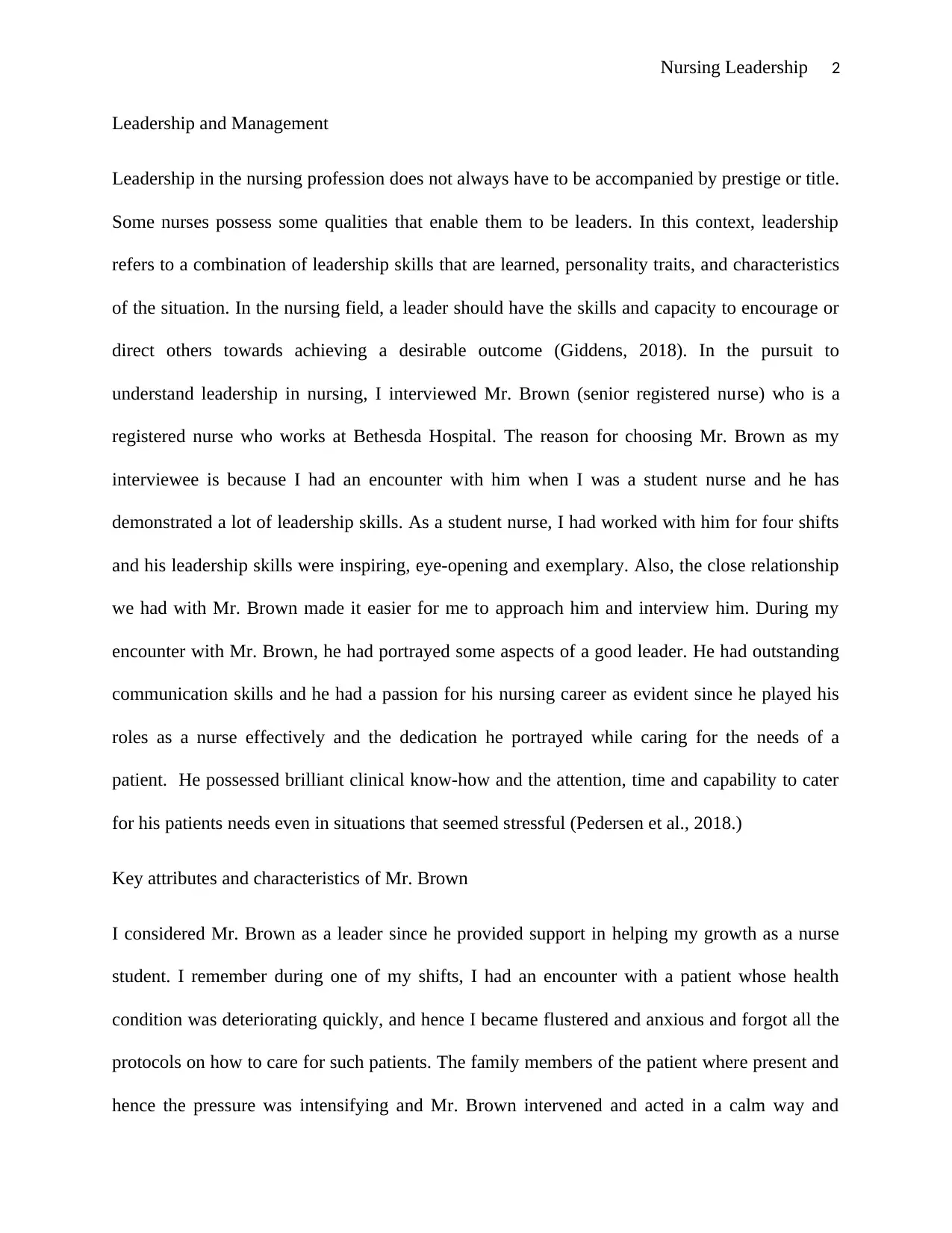
Nursing Leadership 2
Leadership and Management
Leadership in the nursing profession does not always have to be accompanied by prestige or title.
Some nurses possess some qualities that enable them to be leaders. In this context, leadership
refers to a combination of leadership skills that are learned, personality traits, and characteristics
of the situation. In the nursing field, a leader should have the skills and capacity to encourage or
direct others towards achieving a desirable outcome (Giddens, 2018). In the pursuit to
understand leadership in nursing, I interviewed Mr. Brown (senior registered nurse) who is a
registered nurse who works at Bethesda Hospital. The reason for choosing Mr. Brown as my
interviewee is because I had an encounter with him when I was a student nurse and he has
demonstrated a lot of leadership skills. As a student nurse, I had worked with him for four shifts
and his leadership skills were inspiring, eye-opening and exemplary. Also, the close relationship
we had with Mr. Brown made it easier for me to approach him and interview him. During my
encounter with Mr. Brown, he had portrayed some aspects of a good leader. He had outstanding
communication skills and he had a passion for his nursing career as evident since he played his
roles as a nurse effectively and the dedication he portrayed while caring for the needs of a
patient. He possessed brilliant clinical know-how and the attention, time and capability to cater
for his patients needs even in situations that seemed stressful (Pedersen et al., 2018.)
Key attributes and characteristics of Mr. Brown
I considered Mr. Brown as a leader since he provided support in helping my growth as a nurse
student. I remember during one of my shifts, I had an encounter with a patient whose health
condition was deteriorating quickly, and hence I became flustered and anxious and forgot all the
protocols on how to care for such patients. The family members of the patient where present and
hence the pressure was intensifying and Mr. Brown intervened and acted in a calm way and
Leadership and Management
Leadership in the nursing profession does not always have to be accompanied by prestige or title.
Some nurses possess some qualities that enable them to be leaders. In this context, leadership
refers to a combination of leadership skills that are learned, personality traits, and characteristics
of the situation. In the nursing field, a leader should have the skills and capacity to encourage or
direct others towards achieving a desirable outcome (Giddens, 2018). In the pursuit to
understand leadership in nursing, I interviewed Mr. Brown (senior registered nurse) who is a
registered nurse who works at Bethesda Hospital. The reason for choosing Mr. Brown as my
interviewee is because I had an encounter with him when I was a student nurse and he has
demonstrated a lot of leadership skills. As a student nurse, I had worked with him for four shifts
and his leadership skills were inspiring, eye-opening and exemplary. Also, the close relationship
we had with Mr. Brown made it easier for me to approach him and interview him. During my
encounter with Mr. Brown, he had portrayed some aspects of a good leader. He had outstanding
communication skills and he had a passion for his nursing career as evident since he played his
roles as a nurse effectively and the dedication he portrayed while caring for the needs of a
patient. He possessed brilliant clinical know-how and the attention, time and capability to cater
for his patients needs even in situations that seemed stressful (Pedersen et al., 2018.)
Key attributes and characteristics of Mr. Brown
I considered Mr. Brown as a leader since he provided support in helping my growth as a nurse
student. I remember during one of my shifts, I had an encounter with a patient whose health
condition was deteriorating quickly, and hence I became flustered and anxious and forgot all the
protocols on how to care for such patients. The family members of the patient where present and
hence the pressure was intensifying and Mr. Brown intervened and acted in a calm way and
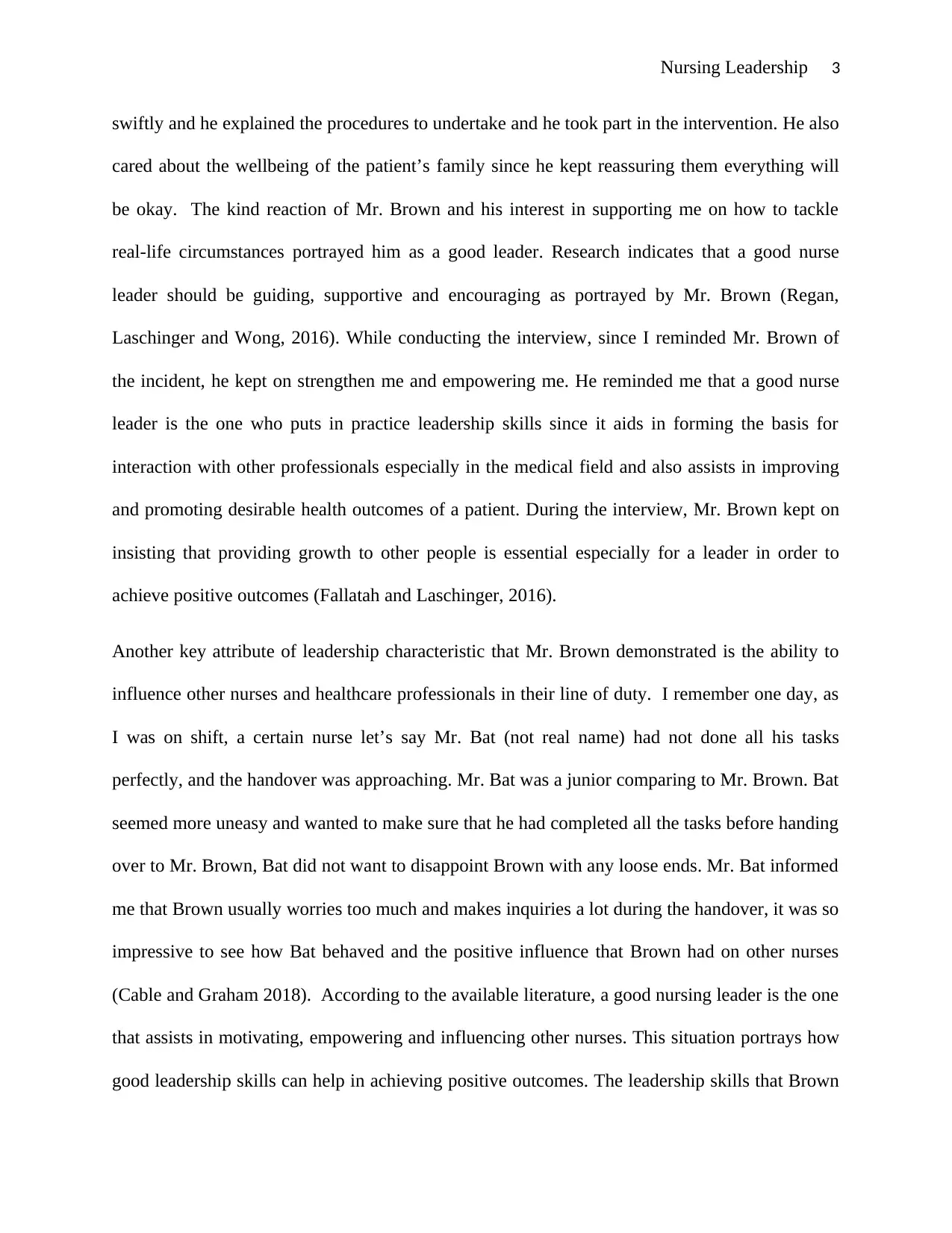
Nursing Leadership 3
swiftly and he explained the procedures to undertake and he took part in the intervention. He also
cared about the wellbeing of the patient’s family since he kept reassuring them everything will
be okay. The kind reaction of Mr. Brown and his interest in supporting me on how to tackle
real-life circumstances portrayed him as a good leader. Research indicates that a good nurse
leader should be guiding, supportive and encouraging as portrayed by Mr. Brown (Regan,
Laschinger and Wong, 2016). While conducting the interview, since I reminded Mr. Brown of
the incident, he kept on strengthen me and empowering me. He reminded me that a good nurse
leader is the one who puts in practice leadership skills since it aids in forming the basis for
interaction with other professionals especially in the medical field and also assists in improving
and promoting desirable health outcomes of a patient. During the interview, Mr. Brown kept on
insisting that providing growth to other people is essential especially for a leader in order to
achieve positive outcomes (Fallatah and Laschinger, 2016).
Another key attribute of leadership characteristic that Mr. Brown demonstrated is the ability to
influence other nurses and healthcare professionals in their line of duty. I remember one day, as
I was on shift, a certain nurse let’s say Mr. Bat (not real name) had not done all his tasks
perfectly, and the handover was approaching. Mr. Bat was a junior comparing to Mr. Brown. Bat
seemed more uneasy and wanted to make sure that he had completed all the tasks before handing
over to Mr. Brown, Bat did not want to disappoint Brown with any loose ends. Mr. Bat informed
me that Brown usually worries too much and makes inquiries a lot during the handover, it was so
impressive to see how Bat behaved and the positive influence that Brown had on other nurses
(Cable and Graham 2018). According to the available literature, a good nursing leader is the one
that assists in motivating, empowering and influencing other nurses. This situation portrays how
good leadership skills can help in achieving positive outcomes. The leadership skills that Brown
swiftly and he explained the procedures to undertake and he took part in the intervention. He also
cared about the wellbeing of the patient’s family since he kept reassuring them everything will
be okay. The kind reaction of Mr. Brown and his interest in supporting me on how to tackle
real-life circumstances portrayed him as a good leader. Research indicates that a good nurse
leader should be guiding, supportive and encouraging as portrayed by Mr. Brown (Regan,
Laschinger and Wong, 2016). While conducting the interview, since I reminded Mr. Brown of
the incident, he kept on strengthen me and empowering me. He reminded me that a good nurse
leader is the one who puts in practice leadership skills since it aids in forming the basis for
interaction with other professionals especially in the medical field and also assists in improving
and promoting desirable health outcomes of a patient. During the interview, Mr. Brown kept on
insisting that providing growth to other people is essential especially for a leader in order to
achieve positive outcomes (Fallatah and Laschinger, 2016).
Another key attribute of leadership characteristic that Mr. Brown demonstrated is the ability to
influence other nurses and healthcare professionals in their line of duty. I remember one day, as
I was on shift, a certain nurse let’s say Mr. Bat (not real name) had not done all his tasks
perfectly, and the handover was approaching. Mr. Bat was a junior comparing to Mr. Brown. Bat
seemed more uneasy and wanted to make sure that he had completed all the tasks before handing
over to Mr. Brown, Bat did not want to disappoint Brown with any loose ends. Mr. Bat informed
me that Brown usually worries too much and makes inquiries a lot during the handover, it was so
impressive to see how Bat behaved and the positive influence that Brown had on other nurses
(Cable and Graham 2018). According to the available literature, a good nursing leader is the one
that assists in motivating, empowering and influencing other nurses. This situation portrays how
good leadership skills can help in achieving positive outcomes. The leadership skills that Brown
⊘ This is a preview!⊘
Do you want full access?
Subscribe today to unlock all pages.

Trusted by 1+ million students worldwide
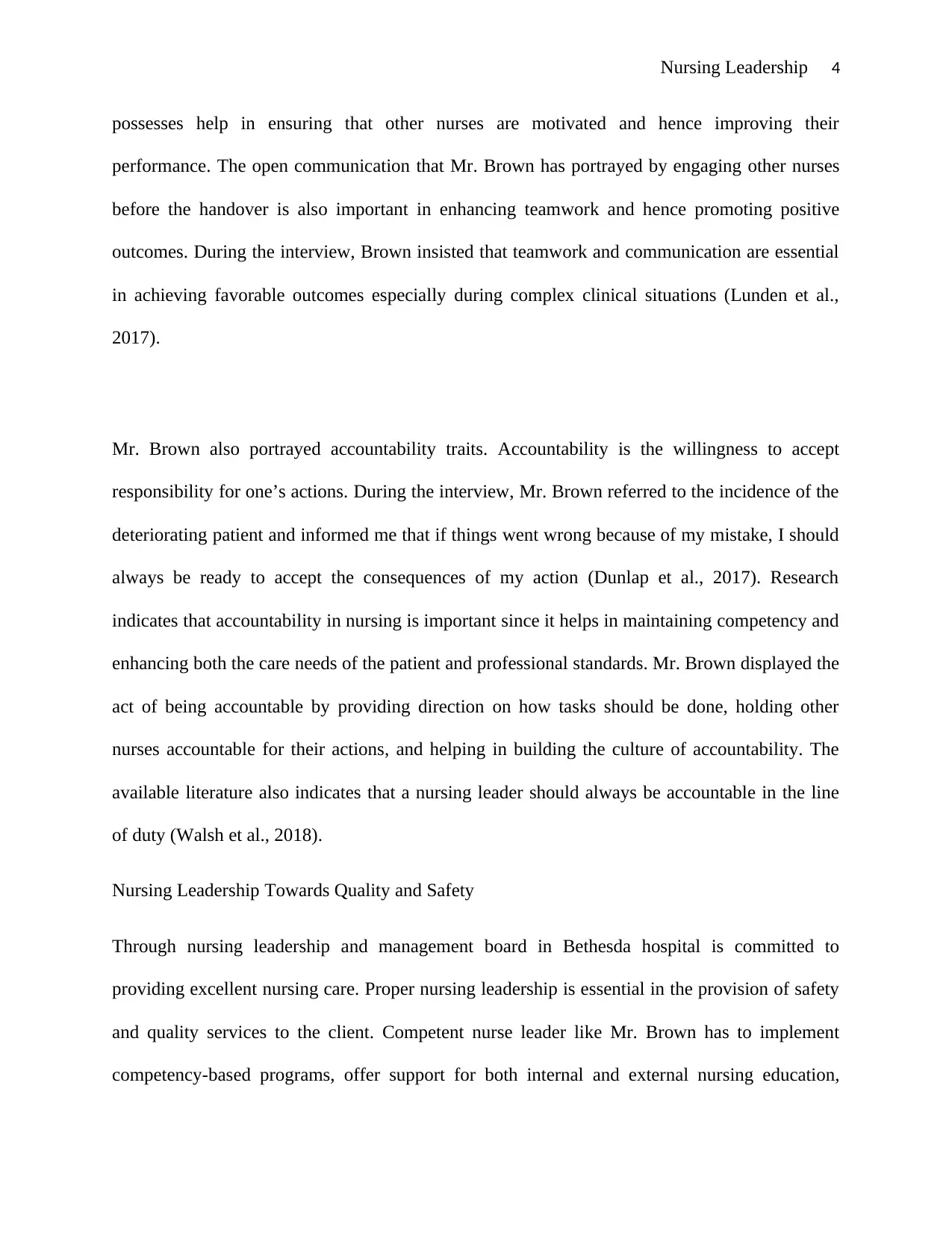
Nursing Leadership 4
possesses help in ensuring that other nurses are motivated and hence improving their
performance. The open communication that Mr. Brown has portrayed by engaging other nurses
before the handover is also important in enhancing teamwork and hence promoting positive
outcomes. During the interview, Brown insisted that teamwork and communication are essential
in achieving favorable outcomes especially during complex clinical situations (Lunden et al.,
2017).
Mr. Brown also portrayed accountability traits. Accountability is the willingness to accept
responsibility for one’s actions. During the interview, Mr. Brown referred to the incidence of the
deteriorating patient and informed me that if things went wrong because of my mistake, I should
always be ready to accept the consequences of my action (Dunlap et al., 2017). Research
indicates that accountability in nursing is important since it helps in maintaining competency and
enhancing both the care needs of the patient and professional standards. Mr. Brown displayed the
act of being accountable by providing direction on how tasks should be done, holding other
nurses accountable for their actions, and helping in building the culture of accountability. The
available literature also indicates that a nursing leader should always be accountable in the line
of duty (Walsh et al., 2018).
Nursing Leadership Towards Quality and Safety
Through nursing leadership and management board in Bethesda hospital is committed to
providing excellent nursing care. Proper nursing leadership is essential in the provision of safety
and quality services to the client. Competent nurse leader like Mr. Brown has to implement
competency-based programs, offer support for both internal and external nursing education,
possesses help in ensuring that other nurses are motivated and hence improving their
performance. The open communication that Mr. Brown has portrayed by engaging other nurses
before the handover is also important in enhancing teamwork and hence promoting positive
outcomes. During the interview, Brown insisted that teamwork and communication are essential
in achieving favorable outcomes especially during complex clinical situations (Lunden et al.,
2017).
Mr. Brown also portrayed accountability traits. Accountability is the willingness to accept
responsibility for one’s actions. During the interview, Mr. Brown referred to the incidence of the
deteriorating patient and informed me that if things went wrong because of my mistake, I should
always be ready to accept the consequences of my action (Dunlap et al., 2017). Research
indicates that accountability in nursing is important since it helps in maintaining competency and
enhancing both the care needs of the patient and professional standards. Mr. Brown displayed the
act of being accountable by providing direction on how tasks should be done, holding other
nurses accountable for their actions, and helping in building the culture of accountability. The
available literature also indicates that a nursing leader should always be accountable in the line
of duty (Walsh et al., 2018).
Nursing Leadership Towards Quality and Safety
Through nursing leadership and management board in Bethesda hospital is committed to
providing excellent nursing care. Proper nursing leadership is essential in the provision of safety
and quality services to the client. Competent nurse leader like Mr. Brown has to implement
competency-based programs, offer support for both internal and external nursing education,
Paraphrase This Document
Need a fresh take? Get an instant paraphrase of this document with our AI Paraphraser
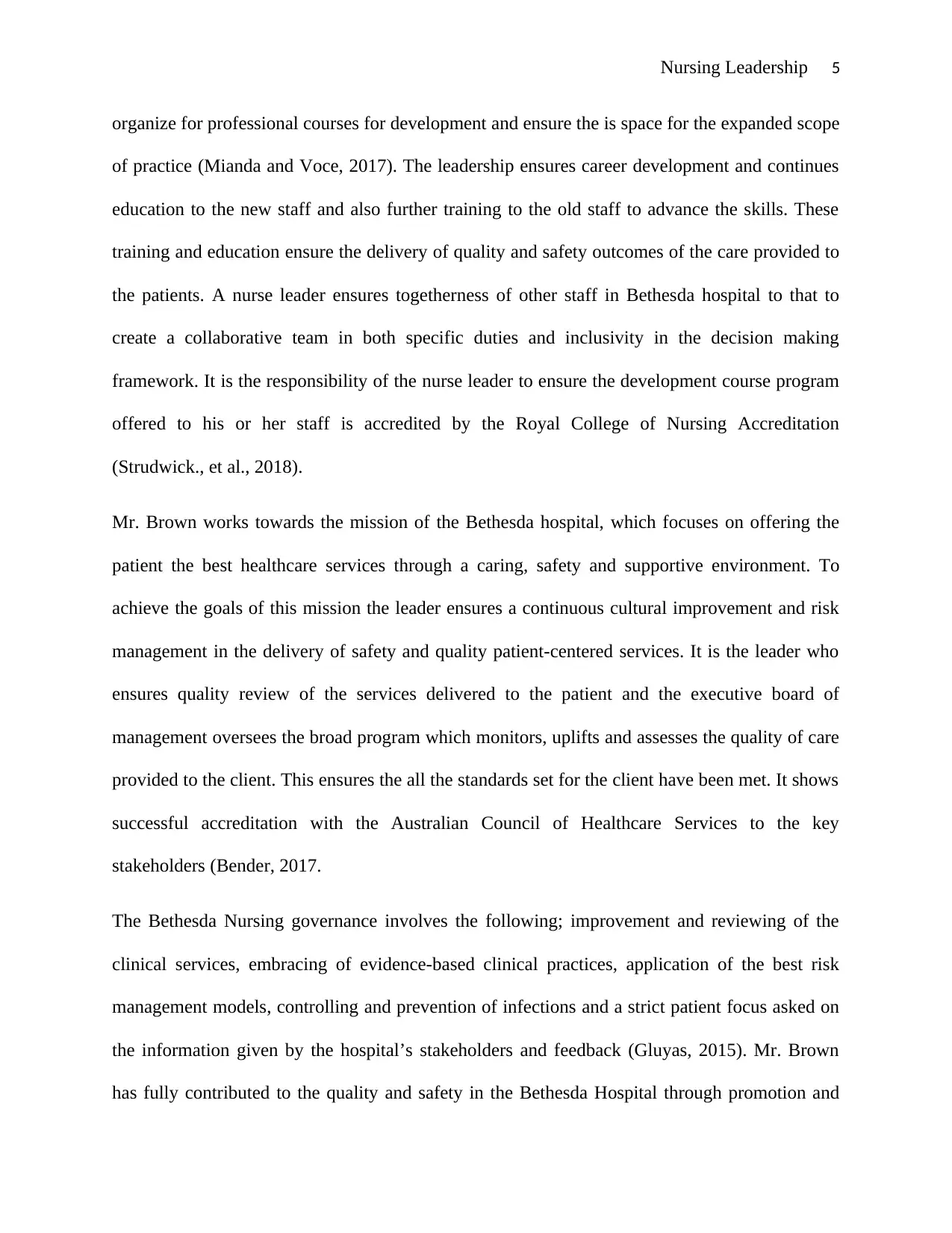
Nursing Leadership 5
organize for professional courses for development and ensure the is space for the expanded scope
of practice (Mianda and Voce, 2017). The leadership ensures career development and continues
education to the new staff and also further training to the old staff to advance the skills. These
training and education ensure the delivery of quality and safety outcomes of the care provided to
the patients. A nurse leader ensures togetherness of other staff in Bethesda hospital to that to
create a collaborative team in both specific duties and inclusivity in the decision making
framework. It is the responsibility of the nurse leader to ensure the development course program
offered to his or her staff is accredited by the Royal College of Nursing Accreditation
(Strudwick., et al., 2018).
Mr. Brown works towards the mission of the Bethesda hospital, which focuses on offering the
patient the best healthcare services through a caring, safety and supportive environment. To
achieve the goals of this mission the leader ensures a continuous cultural improvement and risk
management in the delivery of safety and quality patient-centered services. It is the leader who
ensures quality review of the services delivered to the patient and the executive board of
management oversees the broad program which monitors, uplifts and assesses the quality of care
provided to the client. This ensures the all the standards set for the client have been met. It shows
successful accreditation with the Australian Council of Healthcare Services to the key
stakeholders (Bender, 2017.
The Bethesda Nursing governance involves the following; improvement and reviewing of the
clinical services, embracing of evidence-based clinical practices, application of the best risk
management models, controlling and prevention of infections and a strict patient focus asked on
the information given by the hospital’s stakeholders and feedback (Gluyas, 2015). Mr. Brown
has fully contributed to the quality and safety in the Bethesda Hospital through promotion and
organize for professional courses for development and ensure the is space for the expanded scope
of practice (Mianda and Voce, 2017). The leadership ensures career development and continues
education to the new staff and also further training to the old staff to advance the skills. These
training and education ensure the delivery of quality and safety outcomes of the care provided to
the patients. A nurse leader ensures togetherness of other staff in Bethesda hospital to that to
create a collaborative team in both specific duties and inclusivity in the decision making
framework. It is the responsibility of the nurse leader to ensure the development course program
offered to his or her staff is accredited by the Royal College of Nursing Accreditation
(Strudwick., et al., 2018).
Mr. Brown works towards the mission of the Bethesda hospital, which focuses on offering the
patient the best healthcare services through a caring, safety and supportive environment. To
achieve the goals of this mission the leader ensures a continuous cultural improvement and risk
management in the delivery of safety and quality patient-centered services. It is the leader who
ensures quality review of the services delivered to the patient and the executive board of
management oversees the broad program which monitors, uplifts and assesses the quality of care
provided to the client. This ensures the all the standards set for the client have been met. It shows
successful accreditation with the Australian Council of Healthcare Services to the key
stakeholders (Bender, 2017.
The Bethesda Nursing governance involves the following; improvement and reviewing of the
clinical services, embracing of evidence-based clinical practices, application of the best risk
management models, controlling and prevention of infections and a strict patient focus asked on
the information given by the hospital’s stakeholders and feedback (Gluyas, 2015). Mr. Brown
has fully contributed to the quality and safety in the Bethesda Hospital through promotion and

Nursing Leadership 6
revolution of the following leadership values among the staff in Bethesda Healthcare. He ensured
professionalism, integrity, empathy live, respect and compassion. These values of Mr. Brown
contributed to the impact in shaping healthcare in terms of the political, societal, and economic
forces in Australia. These values benefitted the nursing staff in Bethesda hospital by creating a
strong team environment where everyone felt respected and valued. They enabled the new
member of the team to engage in an orientation program and a comprehensive induction which
makes him/her be acquainted with the hospital and what he/she is required to do at each time
(Waring et al., 2016). Mr. Brown contributed to the additional leave offer for the shifts workers
and also the opportunity to request additional leave. He subsidized the parking whereby Bethesda
hospital offers limited subsidized on-site car park to its staff. This reduced the burden of staff
leaving their cars at home as there was a benefit of convenience and security around the hospital.
As a leader, Mr. Brown relived stress to his junior staff and this contributed to efficiency,
quality, and safety provision of services to the clients (Jeffreys, 2015).
Reflective Practice to reveal Self-awareness
As a nurse with the aim of becoming competent and an able leader in my career, I have learned
the importance of employing the sense of working in a collaborative team with the same mission.
It is important to apply the competent leadership values like empathy, integrity, professionalism,
compassion and respect. Through Mr. Brown’s explanation in the interview, he showed that
togetherness and teamwork are they are the key to the successful delivery of quality and safe care
services to the patients. Mr. Brown has been very supportive and effective to his juniors and this
has encouraged his fellow staff to work hard and in excellence towards achieving the same goal
and aim of Bethesda hospital. Being able to influence and effectively means other staff can listen
revolution of the following leadership values among the staff in Bethesda Healthcare. He ensured
professionalism, integrity, empathy live, respect and compassion. These values of Mr. Brown
contributed to the impact in shaping healthcare in terms of the political, societal, and economic
forces in Australia. These values benefitted the nursing staff in Bethesda hospital by creating a
strong team environment where everyone felt respected and valued. They enabled the new
member of the team to engage in an orientation program and a comprehensive induction which
makes him/her be acquainted with the hospital and what he/she is required to do at each time
(Waring et al., 2016). Mr. Brown contributed to the additional leave offer for the shifts workers
and also the opportunity to request additional leave. He subsidized the parking whereby Bethesda
hospital offers limited subsidized on-site car park to its staff. This reduced the burden of staff
leaving their cars at home as there was a benefit of convenience and security around the hospital.
As a leader, Mr. Brown relived stress to his junior staff and this contributed to efficiency,
quality, and safety provision of services to the clients (Jeffreys, 2015).
Reflective Practice to reveal Self-awareness
As a nurse with the aim of becoming competent and an able leader in my career, I have learned
the importance of employing the sense of working in a collaborative team with the same mission.
It is important to apply the competent leadership values like empathy, integrity, professionalism,
compassion and respect. Through Mr. Brown’s explanation in the interview, he showed that
togetherness and teamwork are they are the key to the successful delivery of quality and safe care
services to the patients. Mr. Brown has been very supportive and effective to his juniors and this
has encouraged his fellow staff to work hard and in excellence towards achieving the same goal
and aim of Bethesda hospital. Being able to influence and effectively means other staff can listen
⊘ This is a preview!⊘
Do you want full access?
Subscribe today to unlock all pages.

Trusted by 1+ million students worldwide

Nursing Leadership 7
to him so as to work as per the ethics and culture of the hospital (Stroh, 2015). In the future, I
will have to apply this character of a nurse leader because it can enable one to be proficient in
delivering effective and competent healthcare services to the people. Accountability is another
character that Mr. Brown explained in his interview and which is very crucial in nursing
leadership as it enables a leader to be observant and engage practically in order to ensure duties
are performed to the best. Since the leader is accountable for everything that pertains to the
nurse’s responsibilities, he/she must be very observant and supervise all the nurses’ operations
within the healthcare. Through proper leadership of Mr. Brown was able to solve the challenges
of car parking within the hospital and this promoted the convenience of the staff. This is a
significant skill to apply while working as a senior in a nursing career (Schussler, Jennings,
Sharp, and Frank, 2016).
to him so as to work as per the ethics and culture of the hospital (Stroh, 2015). In the future, I
will have to apply this character of a nurse leader because it can enable one to be proficient in
delivering effective and competent healthcare services to the people. Accountability is another
character that Mr. Brown explained in his interview and which is very crucial in nursing
leadership as it enables a leader to be observant and engage practically in order to ensure duties
are performed to the best. Since the leader is accountable for everything that pertains to the
nurse’s responsibilities, he/she must be very observant and supervise all the nurses’ operations
within the healthcare. Through proper leadership of Mr. Brown was able to solve the challenges
of car parking within the hospital and this promoted the convenience of the staff. This is a
significant skill to apply while working as a senior in a nursing career (Schussler, Jennings,
Sharp, and Frank, 2016).
Paraphrase This Document
Need a fresh take? Get an instant paraphrase of this document with our AI Paraphraser
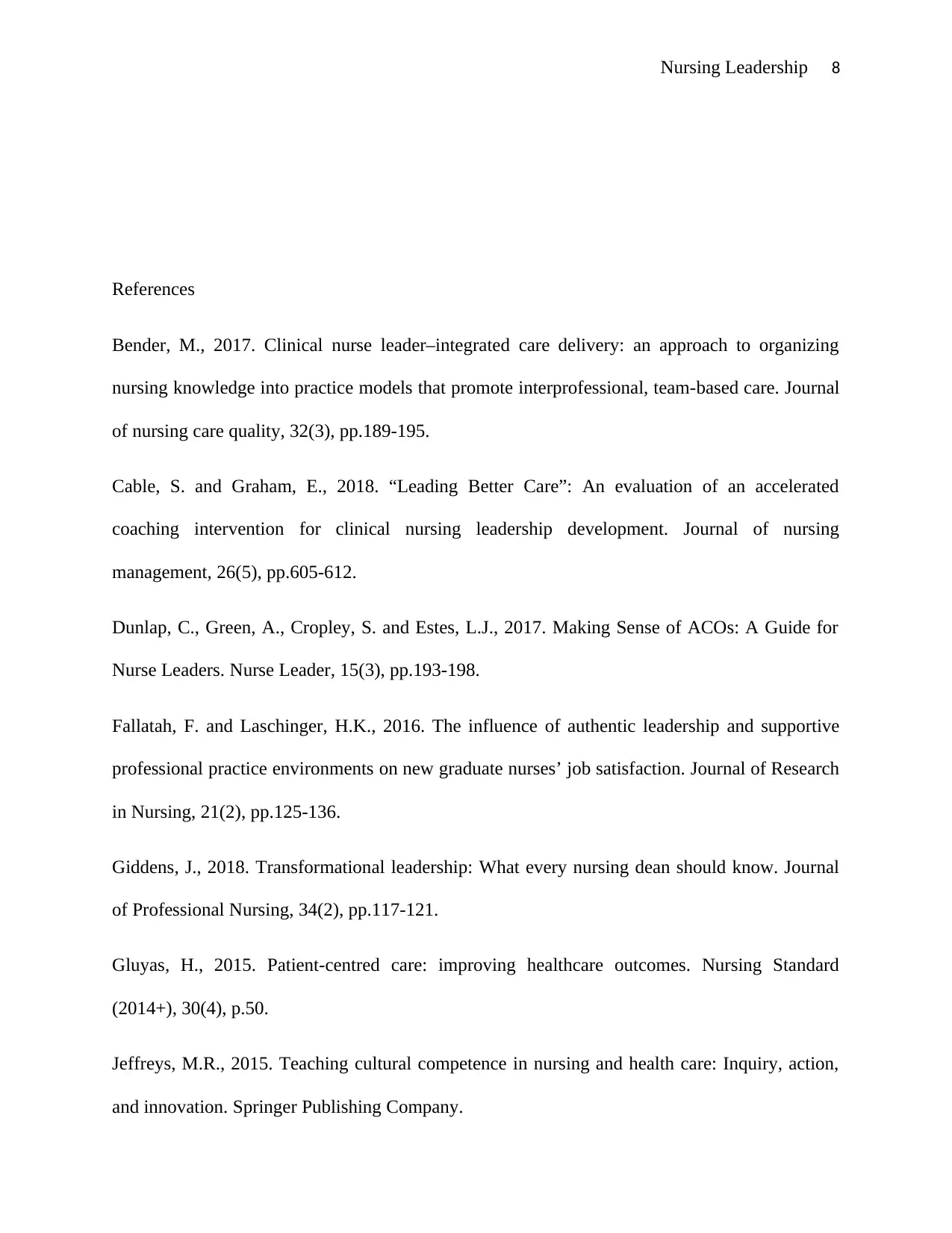
Nursing Leadership 8
References
Bender, M., 2017. Clinical nurse leader–integrated care delivery: an approach to organizing
nursing knowledge into practice models that promote interprofessional, team-based care. Journal
of nursing care quality, 32(3), pp.189-195.
Cable, S. and Graham, E., 2018. “Leading Better Care”: An evaluation of an accelerated
coaching intervention for clinical nursing leadership development. Journal of nursing
management, 26(5), pp.605-612.
Dunlap, C., Green, A., Cropley, S. and Estes, L.J., 2017. Making Sense of ACOs: A Guide for
Nurse Leaders. Nurse Leader, 15(3), pp.193-198.
Fallatah, F. and Laschinger, H.K., 2016. The influence of authentic leadership and supportive
professional practice environments on new graduate nurses’ job satisfaction. Journal of Research
in Nursing, 21(2), pp.125-136.
Giddens, J., 2018. Transformational leadership: What every nursing dean should know. Journal
of Professional Nursing, 34(2), pp.117-121.
Gluyas, H., 2015. Patient-centred care: improving healthcare outcomes. Nursing Standard
(2014+), 30(4), p.50.
Jeffreys, M.R., 2015. Teaching cultural competence in nursing and health care: Inquiry, action,
and innovation. Springer Publishing Company.
References
Bender, M., 2017. Clinical nurse leader–integrated care delivery: an approach to organizing
nursing knowledge into practice models that promote interprofessional, team-based care. Journal
of nursing care quality, 32(3), pp.189-195.
Cable, S. and Graham, E., 2018. “Leading Better Care”: An evaluation of an accelerated
coaching intervention for clinical nursing leadership development. Journal of nursing
management, 26(5), pp.605-612.
Dunlap, C., Green, A., Cropley, S. and Estes, L.J., 2017. Making Sense of ACOs: A Guide for
Nurse Leaders. Nurse Leader, 15(3), pp.193-198.
Fallatah, F. and Laschinger, H.K., 2016. The influence of authentic leadership and supportive
professional practice environments on new graduate nurses’ job satisfaction. Journal of Research
in Nursing, 21(2), pp.125-136.
Giddens, J., 2018. Transformational leadership: What every nursing dean should know. Journal
of Professional Nursing, 34(2), pp.117-121.
Gluyas, H., 2015. Patient-centred care: improving healthcare outcomes. Nursing Standard
(2014+), 30(4), p.50.
Jeffreys, M.R., 2015. Teaching cultural competence in nursing and health care: Inquiry, action,
and innovation. Springer Publishing Company.
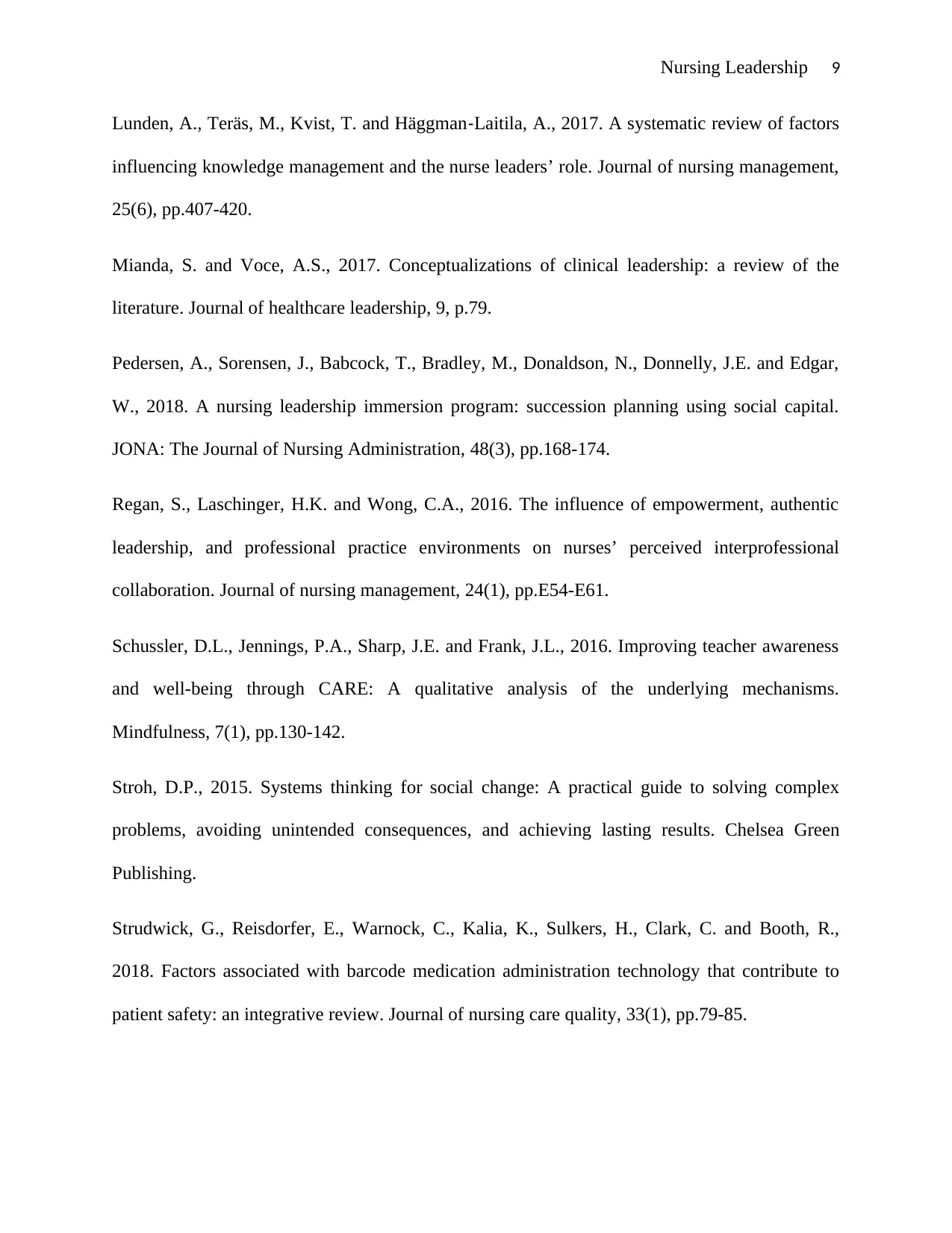
Nursing Leadership 9
Lunden, A., Teräs, M., Kvist, T. and Häggman‐Laitila, A., 2017. A systematic review of factors
influencing knowledge management and the nurse leaders’ role. Journal of nursing management,
25(6), pp.407-420.
Mianda, S. and Voce, A.S., 2017. Conceptualizations of clinical leadership: a review of the
literature. Journal of healthcare leadership, 9, p.79.
Pedersen, A., Sorensen, J., Babcock, T., Bradley, M., Donaldson, N., Donnelly, J.E. and Edgar,
W., 2018. A nursing leadership immersion program: succession planning using social capital.
JONA: The Journal of Nursing Administration, 48(3), pp.168-174.
Regan, S., Laschinger, H.K. and Wong, C.A., 2016. The influence of empowerment, authentic
leadership, and professional practice environments on nurses’ perceived interprofessional
collaboration. Journal of nursing management, 24(1), pp.E54-E61.
Schussler, D.L., Jennings, P.A., Sharp, J.E. and Frank, J.L., 2016. Improving teacher awareness
and well-being through CARE: A qualitative analysis of the underlying mechanisms.
Mindfulness, 7(1), pp.130-142.
Stroh, D.P., 2015. Systems thinking for social change: A practical guide to solving complex
problems, avoiding unintended consequences, and achieving lasting results. Chelsea Green
Publishing.
Strudwick, G., Reisdorfer, E., Warnock, C., Kalia, K., Sulkers, H., Clark, C. and Booth, R.,
2018. Factors associated with barcode medication administration technology that contribute to
patient safety: an integrative review. Journal of nursing care quality, 33(1), pp.79-85.
Lunden, A., Teräs, M., Kvist, T. and Häggman‐Laitila, A., 2017. A systematic review of factors
influencing knowledge management and the nurse leaders’ role. Journal of nursing management,
25(6), pp.407-420.
Mianda, S. and Voce, A.S., 2017. Conceptualizations of clinical leadership: a review of the
literature. Journal of healthcare leadership, 9, p.79.
Pedersen, A., Sorensen, J., Babcock, T., Bradley, M., Donaldson, N., Donnelly, J.E. and Edgar,
W., 2018. A nursing leadership immersion program: succession planning using social capital.
JONA: The Journal of Nursing Administration, 48(3), pp.168-174.
Regan, S., Laschinger, H.K. and Wong, C.A., 2016. The influence of empowerment, authentic
leadership, and professional practice environments on nurses’ perceived interprofessional
collaboration. Journal of nursing management, 24(1), pp.E54-E61.
Schussler, D.L., Jennings, P.A., Sharp, J.E. and Frank, J.L., 2016. Improving teacher awareness
and well-being through CARE: A qualitative analysis of the underlying mechanisms.
Mindfulness, 7(1), pp.130-142.
Stroh, D.P., 2015. Systems thinking for social change: A practical guide to solving complex
problems, avoiding unintended consequences, and achieving lasting results. Chelsea Green
Publishing.
Strudwick, G., Reisdorfer, E., Warnock, C., Kalia, K., Sulkers, H., Clark, C. and Booth, R.,
2018. Factors associated with barcode medication administration technology that contribute to
patient safety: an integrative review. Journal of nursing care quality, 33(1), pp.79-85.
⊘ This is a preview!⊘
Do you want full access?
Subscribe today to unlock all pages.

Trusted by 1+ million students worldwide

Nursing Leadership 10
Walsh, J., Messmer, P.R., Hetzler, K., O'Brien, D.J. and Winningham, B.A., 2018. Standardizing
the bedside report to promote nurse accountability and work effectiveness. The Journal of
Continuing Education in Nursing, 49(10), pp.460-466.
Waring, J., Allen, D., Braithwaite, J. and Sandall, J., 2016. Healthcare quality and safety: a
review of policy, practice and research. Sociology of Health & Illness, 38(2), pp.198-215.
Walsh, J., Messmer, P.R., Hetzler, K., O'Brien, D.J. and Winningham, B.A., 2018. Standardizing
the bedside report to promote nurse accountability and work effectiveness. The Journal of
Continuing Education in Nursing, 49(10), pp.460-466.
Waring, J., Allen, D., Braithwaite, J. and Sandall, J., 2016. Healthcare quality and safety: a
review of policy, practice and research. Sociology of Health & Illness, 38(2), pp.198-215.
1 out of 10
Related Documents
Your All-in-One AI-Powered Toolkit for Academic Success.
+13062052269
info@desklib.com
Available 24*7 on WhatsApp / Email
![[object Object]](/_next/static/media/star-bottom.7253800d.svg)
Unlock your academic potential
Copyright © 2020–2025 A2Z Services. All Rights Reserved. Developed and managed by ZUCOL.




